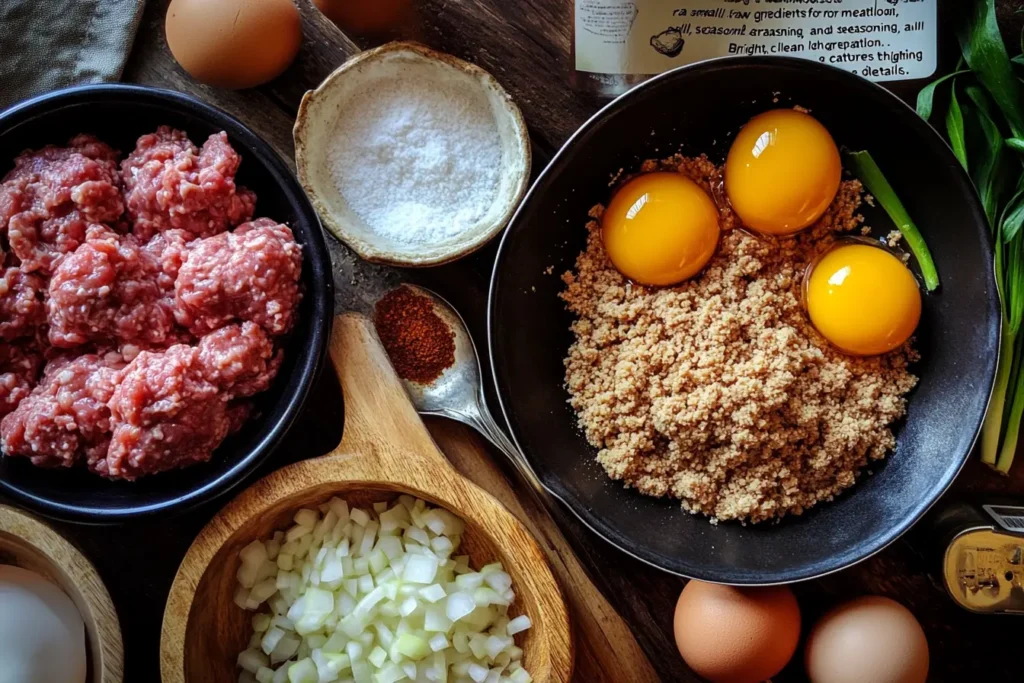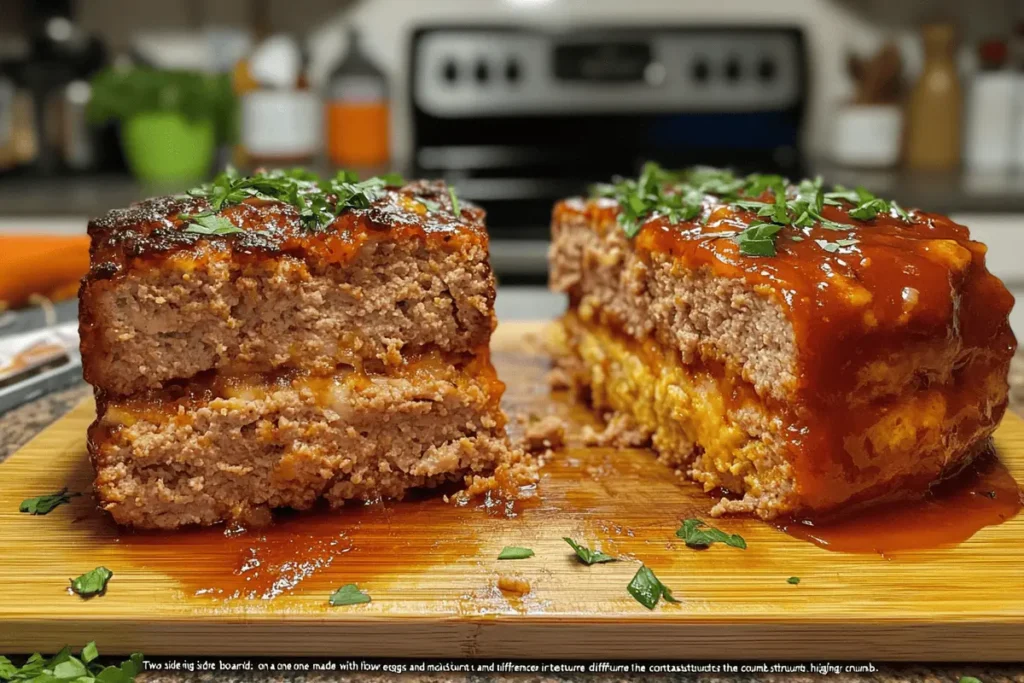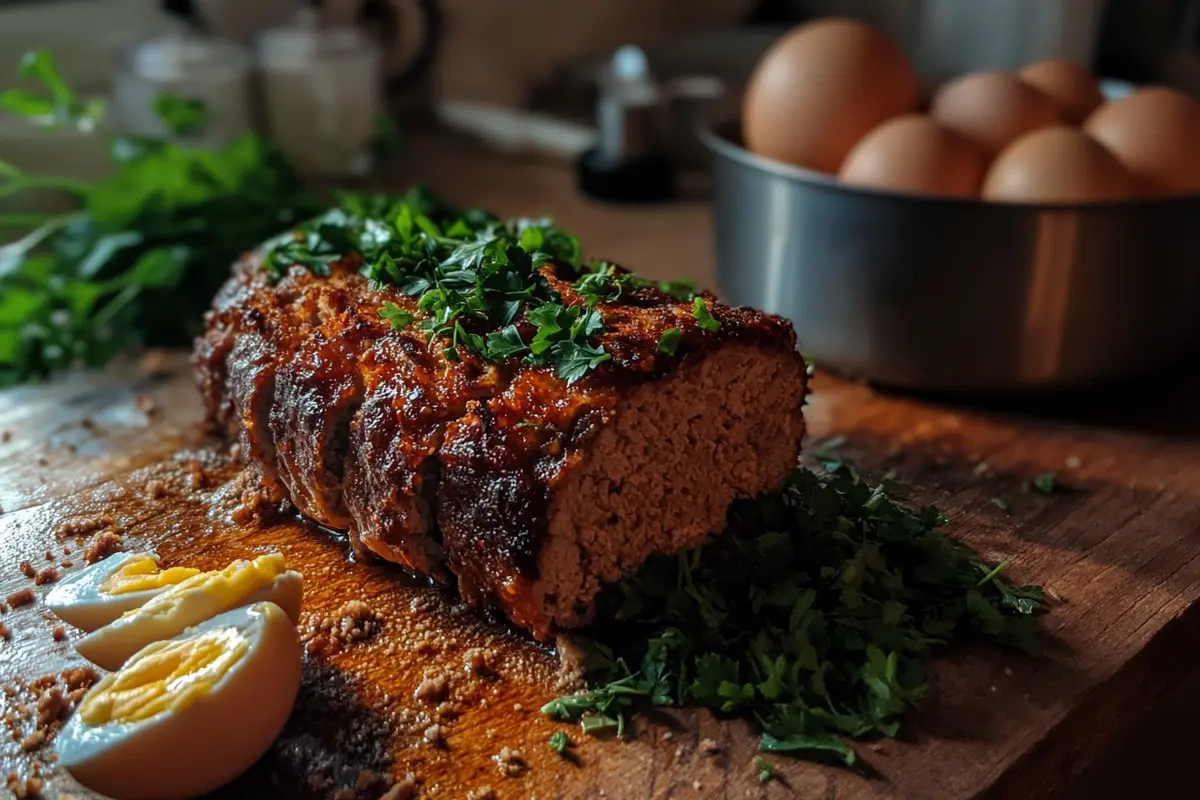How Important is the Egg in Meatloaf?
Meatloaf, a beloved comfort food, brings to mind hearty dinners and warm family gatherings. But have you ever wondered what really holds this culinary classic together? Enter the humble egg. While it might seem like a minor ingredient, the egg plays a pivotal role in achieving the perfect meatloaf. This article delves deep into the importance of eggs in meatloaf, exploring why they’re used, alternatives for those who can’t or don’t eat eggs, and best practices for crafting a perfect loaf. From understanding their role as a binder to exploring nutritional aspects, this guide has you covered.
Let’s crack this topic wide open!
The Role of Eggs in Meatloaf
Why Eggs are a Staple in Meatloaf Recipes
Eggs are more than just an add-in—they’re a key player in making meatloaf what it is. The inclusion of eggs in meatloaf isn’t just about tradition; they bring structure and functionality. Without them, your loaf might crumble under pressure, literally. Think of the egg as the glue that holds your ingredients together, ensuring the loaf keeps its form during cooking and slicing.
Beyond binding, eggs also enhance the meatloaf’s texture. They help create a moist, tender interior that contrasts beautifully with the slightly crisp exterior. Whether you’re working with beef, turkey, or plant-based proteins, eggs can ensure the final product isn’t dry or crumbly.
Eggs as a Binder: Ensuring Structure and Stability
Eggs act as an adhesive, binding the proteins in the meat with the additional ingredients like breadcrumbs, onions, and seasonings. The egg whites contain proteins that coagulate when heated, forming a network that traps moisture and binds everything together. This cohesive structure is what keeps your meatloaf intact when it’s sliced or served.
Think of eggs as the structural backbone of your meatloaf. Without them, it’s challenging to achieve that satisfying slice where every piece stays perfectly intact.

Egg Yolks: Adding Flavor, Moisture, and Richness
The egg yolk, rich in fats, does double duty by adding a creamy richness to the meatloaf. This fatty component contributes to both flavor and moisture, making each bite delectable. Yolks also enhance the overall texture, giving your meatloaf that melt-in-your-mouth quality.
When combined with other moistening ingredients like milk or ketchup, eggs ensure your meatloaf doesn’t dry out during the cooking process. This is particularly important for leaner meats like turkey or chicken, which can become dry more quickly.
Eggs are undeniably essential for traditional meatloaf recipes, serving as both a binder and a flavor enhancer. But what happens if you don’t have eggs on hand or can’t eat them? Stay tuned for Part 2, where we explore whether you can make meatloaf without eggs and some clever alternatives to try!
Exploring Egg Substitutes for Meatloaf
Yes, you can make a delicious meatloaf without eggs! While eggs are a common binding agent, there are plenty of alternatives for those with allergies, dietary restrictions, or simply no eggs in the fridge. Ingredients like breadcrumbs, oats, and even mashed potatoes can act as binders, holding your meatloaf together without sacrificing flavor or texture. For a more plant-based approach, flaxseeds or chia seeds mixed with water create a gel-like consistency that works wonders in binding.
Dairy options, like yogurt or sour cream, also provide moisture and structure. And if you want to keep it simple, a splash of milk combined with breadcrumbs can mimic the binding properties of eggs effectively.
For more guidance, check out this detailed recipe for egg-free meatloaf that highlights the versatility of these substitutes.
Comparing Egg-Based and Egg-Free Meatloaf
The importance of the egg in meatloaf becomes clear when comparing traditional recipes with egg-free versions. Meatloaves made with eggs often have a denser structure, while egg-free versions might be slightly looser but just as flavorful if done correctly. This difference comes down to how well the binder integrates with the other ingredients.
Egg-free meatloaves tend to rely more heavily on additional ingredients for moisture and flavor, such as onions, ketchup, or Worcestershire sauce. While they might take a bit of trial and error to perfect, they’re an excellent option for anyone looking to avoid eggs for health or ethical reasons.
Challenges of an Egg-Free Meatloaf
Without eggs, meatloaf can sometimes crumble during slicing. To avoid this, ensure your alternative binding agents are evenly distributed throughout the mixture. Overmixing, however, can make the loaf tough, so finding the right balance is crucial.
Additionally, some substitutions like mashed potatoes or dairy products might alter the overall taste or texture slightly, so adjustments to seasoning might be needed. But with a little experimentation, you can achieve a loaf that’s cohesive, moist, and packed with flavor.
Part 3: Best Practices for Using Eggs in Meatloaf
How Many Eggs Should You Use?
Getting the egg-to-meat ratio right is key. Typically, one large egg per pound of meat is the golden rule. This ensures that the loaf is neither too dry nor too dense. For larger batches, increasing the egg count proportionally is essential for maintaining that perfect balance of flavor and structure.
Combining Eggs with Other Ingredients for Maximum Effect
When adding eggs, mix them thoroughly with your wet ingredients like milk or Worcestershire sauce before combining them with the meat. This helps distribute the egg evenly, preventing any pockets of dryness. Pairing eggs with breadcrumbs or oats enhances the binding effect, as these ingredients absorb moisture and lock it in during cooking.

Common Mistakes When Adding Eggs
One common pitfall is using too many eggs, which can make the meatloaf overly dense and rubbery. Conversely, too few eggs can lead to a crumbly loaf that falls apart. Another mistake is adding eggs directly to the meat without whisking, which can result in uneven binding. Always whisk the eggs separately for the best texture.
These practices ensure that your meatloaf achieves its signature hearty yet tender texture, reinforcing just how important the egg in meatloaf truly is. Curious about more alternatives and techniques? Keep reading to explore creative binding agents and nutritional insights!
Bread Crumbs, Oats, and Their Role in Binding
When it comes to replacing eggs in meatloaf, bread crumbs and oats are some of the most reliable options. They not only provide structure but also soak up the juices from the meat, keeping the loaf moist. The key is to combine them with a liquid, such as milk, to mimic the binding properties of eggs. This mixture acts as a paste that holds the ingredients together during cooking.
Oats are an excellent choice for those looking to add a subtle texture to their meatloaf. They work best when slightly ground or used as quick oats, as they blend seamlessly into the mixture.
For more inspiration, check out this recipe for egg-free meatloaf, which highlights bread crumbs and oats as essential substitutes.
Dairy Options: Milk, Cheese, and Yogurt
Dairy products like milk, cheese, and yogurt can step in as binding agents while adding a creamy texture and richness. Milk is often used alongside bread crumbs, creating a slurry that locks in moisture. Meanwhile, cheese, particularly grated varieties like Parmesan, adds a slight tang and helps the loaf hold its shape.
Yogurt is another versatile alternative, especially in recipes where a tangy flavor complements the other ingredients. Its thicker consistency also makes it a suitable replacement for eggs, especially when paired with dry ingredients like oats or bread crumbs.
Plant-Based Alternatives: Flaxseeds and Chia Seeds
For those seeking plant-based options, flaxseeds and chia seeds are fantastic substitutes. When mixed with water, both form a gel-like consistency that binds ingredients much like eggs do. The ratio is simple: one tablespoon of seeds to two and a half tablespoons of water. Let the mixture sit for 5-10 minutes, and you’ve got a natural, egg-free binder ready to use.
These alternatives are perfect for anyone looking to maintain a plant-based or allergen-free diet while still enjoying the texture and flavor of a classic meatloaf.
Nutritional Perspective on Eggs in Meatloaf
Eggs as a Source of Protein and Healthy Fats
Eggs are not just functional in meatloaf—they’re nutritious too. They’re packed with high-quality protein and healthy fats, which enhance the overall nutritional profile of the dish. A single egg contains about 6 grams of protein, making it an excellent addition for those looking to increase their protein intake.
The fats in eggs, particularly from the yolk, also contribute to the creamy texture and rich flavor of meatloaf. These fats can be especially important when using lean meats like turkey or chicken, which may otherwise result in a drier texture.
Caloric Impact of Eggs in Meatloaf
Eggs are relatively low in calories, making them an efficient way to add nutrients without drastically increasing the caloric count. A large egg contains roughly 70 calories, which is minimal when spread out across an entire meatloaf. For health-conscious eaters, this makes eggs an easy choice for both flavor and function.
Health Considerations for Egg-Free Recipes
While eggs are nutritious, not everyone can or wants to eat them. For those with allergies, intolerances, or specific dietary needs, substitutes like flaxseeds or chia seeds provide a great source of fiber and omega-3 fatty acids. These alternatives can even enhance the health benefits of your meatloaf, depending on your nutritional goals.
By exploring these nutritional benefits and alternatives, it’s clear how important the egg in meatloaf truly is—not just for its binding properties but also for its contributions to flavor and health. For more delicious recipes, check out our site for additional meal ideas that cater to various dietary preferences!
Why Do Eggs Prevent Meatloaf from Falling Apart?
Eggs act as a natural glue, holding all the ingredients together in a cohesive mixture. The proteins in egg whites coagulate during cooking, creating a network that binds the meat and other ingredients. Meanwhile, the yolk adds moisture and richness, ensuring the loaf doesn’t dry out. Together, they form the structural backbone of a well-made meatloaf. Without them, your loaf might crumble under the knife.
What Happens if You Don’t Use Eggs in Meatloaf?
Leaving eggs out of your meatloaf can result in a drier, more crumbly dish. However, you can compensate with egg substitutes like breadcrumbs and milk, flaxseed mixtures, or even mashed potatoes. While the texture might differ slightly, the flavor can remain just as rich, especially with the right seasonings.
Are Eggs Necessary for Meatloaf Flavor?
Interestingly, eggs don’t contribute much to the overall taste of meatloaf. Their main job is structural, although the yolk adds a subtle creaminess. Flavor largely comes from the meat, spices, and other ingredients like onions or garlic. So, while eggs are important for texture, they aren’t a must for flavor.
What Can Replace Eggs in Meatloaf for Dietary Restrictions?
Several ingredients can step in for eggs, depending on dietary needs. Vegan options like flaxseed and chia seed gels are popular, while dairy options like yogurt or sour cream work well too. Even mashed vegetables like potatoes or sweet potatoes can act as binders, adding both texture and flavor to your dish.
Conclusion – How Important is the Egg in Meatloaf?
In summary, the egg is a powerhouse ingredient in meatloaf, playing a crucial role in binding the ingredients, adding moisture, and enriching the overall texture. Its ability to hold the loaf together ensures that it slices cleanly and serves beautifully. While not a significant contributor to flavor, the egg’s structural contributions make it indispensable in traditional recipes.
However, for those with dietary restrictions or preferences, plenty of creative substitutes exist. Whether you’re using breadcrumbs and milk, flaxseed gel, or mashed vegetables, you can still achieve a satisfying meatloaf that meets your needs. The key is finding the right balance of binders and moisture to keep your loaf intact and flavorful.
Ultimately, understanding how important the egg in meatloaf is can help you create the perfect dish, whether sticking to tradition or trying a fresh take. With so many binding options available, anyone can enjoy this classic comfort food. So, experiment with ingredients and make the meatloaf that’s perfect for you!
Adding Unique Ingredients for Flavor and Texture
Meatloaf is a blank canvas for creativity. While traditional recipes rely on eggs, breadcrumbs, and basic seasonings, you can add a personal twist with unique ingredients. Try incorporating grated vegetables like zucchini or carrots for extra moisture and nutrients. Cheese, especially sharp cheddar or Parmesan, can elevate the flavor and act as a subtle binder.
For a global spin, add spices or seasonings from different cuisines. Think cumin and coriander for a Middle Eastern touch or soy sauce and ginger for an Asian-inspired loaf. These additions not only enhance flavor but also help compensate if you’re making an egg-free version.
Experimenting with Alternative Protein Sources
If you’re looking to move beyond the classic ground beef, consider experimenting with alternative proteins. Ground turkey or chicken creates a lighter meatloaf, while plant-based options like lentils or chickpeas work well for vegetarian versions. Just remember, binding becomes even more important with these ingredients. This makes understanding how important is the egg in meatloaf crucial, even when adapting recipes for new diets.
Final Thoughts on the Role of Eggs in Meatloaf
The Egg’s Essential Role in Meatloaf
It’s clear that eggs are more than just another ingredient in meatloaf—they’re the foundation of its structure. They keep the loaf intact, prevent crumbling, and add a richness that’s hard to replicate. Whether you’re using classic ground beef or experimenting with alternative proteins, eggs play a pivotal role in achieving that perfect balance of flavor and texture.
When to Experiment with Substitutes
That said, not everyone can or wants to use eggs. Thankfully, a variety of substitutes can provide similar binding properties. Flaxseeds, breadcrumbs, oats, and even mashed vegetables can all work, allowing you to tailor your meatloaf to meet dietary needs or personal preferences.
Ultimately, how important is the egg in meatloaf depends on the recipe and the eater. Whether you stick to tradition or explore new variations, understanding the role of eggs or their alternatives will ensure your meatloaf turns out moist, flavorful, and satisfying every time. So, gather your ingredients, get creative, and enjoy the endless possibilities of this timeless comfort food!
Updated Section: Nutritional Insights of Using Eggs in Meatloaf
Calories and Nutritional Content of Meatloaf with Eggs
Eggs play a key role in not just binding but also boosting the nutritional profile of meatloaf. Below is the approximate nutritional content per 100g of meatloaf made with eggs:
| Nutrient | Amount (per 100g) |
|---|---|
| Calories | 250 kcal |
| Protein | 16 g |
| Fat | 15 g |
| Saturated Fat | 5 g |
| Cholesterol | 80 mg |
| Carbohydrates | 10 g |
| Fiber | 1 g |
| Sodium | 450 mg |

